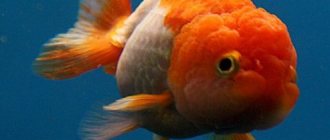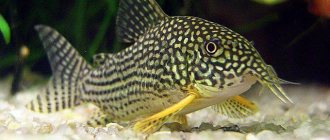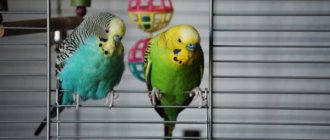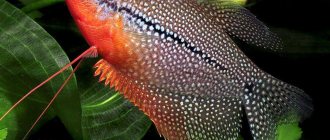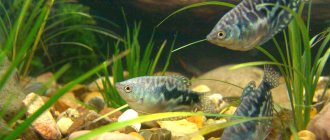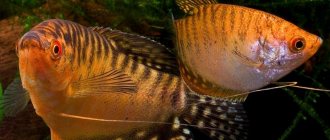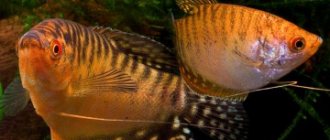Gourami
Simplicity of content:
Latin name: Trichopodus leerii
Lifespan: 10 years
Maximum size: 14 cm.
Average cost: 100 rub.
Pearl gourami is an unpretentious aquarium fish with an attractive appearance. Its bright color and soft character make it possible to add other species of fish as neighbors. Gourami has become popular among aquarists due to its ease of maintenance, ease of care and outstanding appearance.
Motherland
Most often found in India and Thailand. All types of gourami live on the islands of Sumatra, Borneo, Java and on the two peninsulas of Indochina and Malay. In nature, pearl, kissing and moon gourami are common.
Types of gourami from right to left: pearl, lalius, marbled, kissing.
The commercial gur is the largest representative of its species and is common in the Greater Sunda Islands. It is not intended for breeding in an aquarium due to its large size. its length reaches 60 cm.
Today, the number of this species has reached a critical level, so in its homeland it is protected and listed in the Red Book.
Gourami live in flowing and still waters. Thanks to the ability to breathe oxygen, they can easily tolerate being in polluted, stagnant ponds, ditches and reservoirs.
Habitats of different species
Among the many types, the most common are:
- Kissing. His homeland is Thailand. The fish received this name due to the structure of its mouthparts. When their lips collide, she makes a special sound similar to a kiss.
- Pearl gourami is the most beautiful species compared to the others. The color of the fish resembles pearl dust.
- Spotted, most often found in Vietnam and Thailand. It can be of different colors and has a calm character.
- Honey. His homeland is India. The color of the fish is yellow-golden.
- Blue lives on the island of Sumatra. Its name comes from its green-blue color, which becomes even brighter with the onset of spawning.
- Red and gold varieties were developed by breeders. They are more demanding, less able to withstand uncomfortable living conditions and have a shorter lifespan.
History of discovery
In the 19th century, the pearl species was discovered by a scientist from France, Pierre Carbonnier, who studied issues related to the acclimatization of tropical animals and was involved in the spread of gourami as an aquarium species. But here difficulties awaited him. At home, the fish lived in ditches and rice fields. The water in them was dirty, stagnant and cloudy. In this regard, the opinion about the great endurance and vitality of the fish has spread. But it was not possible to bring at least one specimen to the Old World; the fish died on the way. After another failure, research and transportation attempts stopped, and the cause of the high mortality rate was clarified only 20 years later.
Gourami rises to the water's edge to capture atmospheric air from the surface, necessary for labyrinthine breathing.
The main feature of pearl gourami is the need to breathe atmospheric air. They began to fill the container halfway with water only in 1896, and then it was possible to transport the first fish to Europe. Later, thanks to A.S. Meshchersky, this species appeared in Russia. He was a well-known aquarist at that time, who bought the gur from Pierre Carbonnier himself.
What to feed a grumbling gourami
Pearl gourami beautiful photo
When feeding, gourami are completely unpretentious and are ready to feast on any food they find. Like other fish, gourami will be very grateful for a varied diet. After all, feeding any aquarium fish must be correct - balanced, varied. This fundamental rule is the key to successfully keeping any fish. The standard and well-known TetraMin food is perfect for gourami.
It should be noted that when purchasing any dry food, you should pay attention to the date of its manufacture and shelf life, try not to buy food in bulk, and also store the food in a closed state - this will help to avoid the development of pathogenic flora in it.
Nutrition and behavioral characteristics
And although this species has a calm character, it is still quite timid. In cases of danger, they seek shelter in algae, stones and small holes. With proper care, the life expectancy of females is 12 years, males 14 years. Puberty begins at 8 months. During spawning it makes characteristic clicking sounds. In addition, the pearl gourami recognizes its owner or the people who feed it.
Since the mouth cavity of the fish is quite small, you need to buy small food. Food must be given twice a day.
03:43
Gourami, maintenance, feeding, reproduction, species, aquarium
Types of food:
- Live food. They can be purchased, small bloodworms, coretra, tubifex, daphnia work well, or they can be made from wood lice, earthworms, mealworms and microworms. Artemia is suitable for young specimens.
- Frozen food. Gourami will eat any small frozen food. Tubifex, bloodworms, raspberries, cyclops, microplankton, crushed mussels or shrimp.
- Dry food. It is recommended to add special diets containing carotenoids that improve the color of the fish.
- Products from the human table. Gourami will happily eat finely chopped shrimp and mussels. They should be given no more than 2 times a week. Delicacies for this type are considered to be pre-grated cottage cheese, shavings of meat and processed cheese. You should not feed your fish with similar products more than once every 2 weeks.
- Homemade food. You can make your own food. Now there are many recipes, including for labyrinth fish. Often these foods are protein based, so maintaining a balance will be difficult.
Based on this diagram, you can easily select dry food for your pearls.
Not all gourami will be able to eat the above foods. Small species will not cope with large-sized food, while large fish will not eat small-cut food.
Interesting Facts
All fish of the genus Trichogaster are considered to be the ancestors of the commercial giant fish that lives off the coast of Indonesia. Its species name is Osphromenus goramy - “true gourami”, while pearl and other species of stringworms, in fact, according to the official classification, have nothing to do with the name goramy.
Modern biologists have so far unofficially classified Trichogasters with another genus - Trichopodus, and both nomenclatures are used by ichthyologists in relation to thread-bearing gourami.
Watching the “pearl” fish, you can note several interesting facts from their life in the aquarium:
Adult gourami can live without food for 2 weeks
- able to tolerate short-term temperature decreases of up to 20 °C and increases of more than 30 °C;
- they like to suck in food from the surface along with water, which then comes out through the gills;
- before eating food, they try to taste it - they mull food fragments in their mouth several times, spit them out, and then swallow them;
- copy behavior, imitating their relatives;
- can live without food brought into the aquarium for up to 2 weeks (during this time they eat harmful algae and are considered “orderlies” of their ecosystem);
- capable of spawning at temperatures not lower than 20 ° C;
- during mating games they can make clicking sounds;
- produce fry significantly smaller in size than the brood produced by the marbled gourami;
- They stop spawning at 14 months, and it is no longer possible to obtain offspring from such individuals.
By crossing different species - a “pearl” male and a “blue” female - a spectacular hybrid was obtained. Morpha inherited a light blue body and a pattern of white spots, but without the pearlescent sheen. It is distinguished by its white tail and scattered orange patches on the anal fin.
Appearance
Pearl gouramis are labyrinth fish with their own structural features. Oval body, slightly flattened at the sides. Depending on whether it is a female or a male, the length ranges from 10 to 14 cm. The main distinguishing feature is the fins. They are:
- The breasts are transparent in color and almost invisible. They start in the middle of the body and reach the end.
- The pelvic fins are filaments and are a tactile organ.
- Anal. It runs from the anus to the base of the tail.
- Its tail shape resembles a two-pronged fork.
Both male and female gourami look bright and distinctive.
You can tell if it is a female or a male by looking at the size of the fins. In males they are much longer. They are distinguished by their bright coloring, which intensifies during spawning.
Color
Pearl gourami is named so due to the small white spots located on the body that resemble pearls. The ventral region and chest are coral, and the back is light green. In other places, the scales may be dark silver, red-violet. On the body of the fish you can see a dark stripe that starts in the head area and ends on the tail.
This species has its own peculiarity. They need oxygen. It is especially important to take this into account when transporting gourami. If the fish is left without air for a long time, it will die. Therefore, the container is filled halfway with water and periodically opened, providing access to fresh air.
Description
Gourami are able to breathe air from the surface using a labyrinthine breathing apparatus.
Appearance
Elongated, laterally compressed body. The pelvic fins are long, thread-like, and are used for sensing the surrounding space. The color varies from olive to silver. Pearlescent spots all over the body. The scales form a dark stripe in the middle.
In the wild they grow up to 12 cm. In captivity 7–10 cm.
Behavior
Labyrinth fish lead a peaceful lifestyle, do not fight for territory and do not attack other inhabitants of reservoirs. Pearlfish make sounds that are strong during the spawning period. They recognize the owner. Mother of pearl knocks down insects with thin streams of water.
Lifespan
Life span is from 7 to 9 years.
Care and maintenance
If we compare pearl gourami with other varieties, they will be more demanding. But don’t be afraid; you don’t need any special skills to maintain them. You just need to know the basic requirements for water and aquarium setup.
Water parameters
| Volume of water (liters per 1 individual) | Temperature (°C) | Acidity (pH) | Hardness (dGH) |
| 20 | 23-27 | 6-7 | no more than 14 |
It is advisable to keep at least 6 individuals in one aquarium. The ideal match is 1 male and 3 females.
It is a special pleasure to watch a flock of gourami and their relationships.
To create the most comfortable place for a school of fish, it is recommended to choose an aquarium with a volume of more than 100 liters. In nature, they often jump out of the pond, so you will have to purchase a glass lid with small holes for air circulation. It also serves to protect water from apartment air. Because the temperature in the room can be very different from the temperature of the aquarium water.
History of discovery
The genus Trichogaster, to which the pearl gourami is classified, was founded in 1801 by two German scientists: ichthyologist Markus Bloch and naturalist Johann Schneider. The literal translation of the word trichogaster defines the main feature of fish of this genus (thread-like rays of the pectoral fins), from the derivatives thrix - hair and gaster - belly.
The species itself was discovered in 1852 by the Dutch ichthyologist Pieter Blecker. Gourami appeared in European aquariums in 1865 thanks to the French naturalist Pierre Carbonnier. He was actively involved in the acclimatization of tropical fish on the European continent. On expeditions to Southeast Asia, Blecker caught wild specimens of threadworts and delivered them to Paris in wooden barrels. Initially, such an event ended in the death of the animals, until scientists assessed the vital functions of the fish.
Aquarium
Light
The native habitat for gourami is swamps or ponds with a large number of tall plants, which means that the light in the aquarium must be diffused. To illuminate it, buy lamps with dim, cold light. Floating plants should be placed on the surface of the pond.
The pistia on the surface of the aquarium will protect the crayfish from excessive lighting, and the root system will create additional shelter in the water column.
Filters
It is imperative to filter water. It is best to choose moderate modes, since this species does not like fast currents.
Aquarium preparation
It should contain large floating plants such as elodea, duckweed or riccia. Dark sand is best as a soil.
How to distinguish males from females?
Males and females are easy to distinguish from each other by external features. They are so obvious that it is almost impossible to confuse the sex of the fish.
Gourami gender differences:
- males have a larger body and elongated fins - dorsal and anal;
- males have brighter colors, they are much more attractive and more decorative;
- females have an orange throat, while males have a bright red throat;
- The caudal fins of males are pointed, while those of females are rounded.
Compatibility
Pearl gouramis are calm and non-aggressive fish, characterized by timidity. They will hide until they get used to their new habitat. Therefore, at first it is necessary to ensure that the gouramis receive food. Compatibility of gourami with other fish similar in character and size is good.
Gouras feel great in the company of tetras. The photo shows minors and pearl gouramis in the same aquarium.
Other gourami species can be aggressive towards their neighbors.
Good compatibility
- Neons;
- Rainbows;
- Boots;
- Tetras;
- Danio;
- Cichlids;
- Angelfish;
- Minors;
- Catfish.
Poor compatibility
- Barbs;
- Cockerels;
- Parrot fish;
- Goldfish;
- Astronotuses;
- Discus;
- Shrimps;
- Piranhas.
Based on the table presented, you can create a favorable, peaceful environment in your aquarium.
Gura are fully compatible with angelfish and platies.
They can get along with guppies and loaches. Completely incompatible with bettas, astronotus, shrimp, piranhas, and goldfish.
Adviсe
- transportation is an important step, do not damage the fins when moving or transplanting;
- cleanliness and temperature of the water are the key to the health of pearl fish;
- a spawning pair that does not show mutual sympathy will not produce offspring;
- mandatory quarantine for newcomers;
- Do not house gouramis with aggressive species.
Exotic and fascinating pearls will decorate the aquarium and will not harm the neighbors. Pearlescent gourami is an excellent option for beginner aquarists.
Previous
FishSecrets of keeping Corydoras catfish
Next
FishWhat do you need to know when keeping flamingos with cichlases?
Diseases
Any type of fish has a list of inherent diseases. Pearl gourami was no exception. One sick fish can infect all the inhabitants of the aquarium. Therefore, it is so important to keep them in good conditions and monitor their health. Often, fish begin to get sick due to injuries received during transportation, temperature changes, inappropriate water parameters in the aquarium, poor care and low-quality food.
Common diseases for pearl gourama are:
Lymphocystosis
This is a virus that infects the scales of fish and changes the cells of the mucous membrane. Blisters appear on the skin of the fish, which can be noticed immediately. The affected area becomes larger over time, then it breaks down and the virus begins to spread in the aquarium. Often the first signs can be seen on the fins, then they appear in other areas.
Pseudomonosis
This is a peptic ulcer caused by bacteria belonging to the group of pseudomonas. They end up in aquarium water with sick animals, soil and plants. In a sick individual, dark areas form on the scales, developing into bleeding ulcers. Infected fish are kept in a separate container without plants. Potassium permanganate is used for treatment. Dilute 0.5 grams of the drug per 10 liters of water and leave the fish in this environment for 15 minutes. When there is no separate container or aquarium, treatment is carried out with bicillin 5, 500,000 units of medicine per 100 liters of water. This procedure is repeated 6 times, after each use you should take a break for 1 day.
Aeromonosis
This is an infectious disease caused by the bacterium Aeromonos punctata, which most often appears in dirty, cold aquariums. Sick fish refuse to eat, move little and lie down on the ground. The fins and body are covered with blood stains, and the abdominal area is swollen.
The disease is not only contagious, but also difficult to cure. Sick fish are killed, and the aquarium is disinfected with a special solution.
Diseases
Gourami have strong immunity, but are susceptible to some diseases. If there are unusual changes in appearance or behavior, transfer the fish to another container. Before planting in the main aquarium, be sure to quarantine newcomers for at least 2 weeks.
The most common causes of diseases:
- injuries during transplantation or transportation;
- improper care;
- mismatch of water parameters;
- a sharp drop in temperature;
- excess food;
- poor-quality food or food contaminated with parasites.
More often, health problems are caused by the difference between water and room temperatures. By swallowing cold air, gouramis catch colds. Treatment consists of adjusting temperatures.
Reproduction
Puberty occurs at 8 months. When there are 12 days before the expected spawning, it is necessary to separate the male and female from each other in separate containers. At this time it is better to feed bloodworms and cyclops. The protein content should be increased. When the water temperature is 29 - 30 °C, reproduction can begin.
Remember the main rule, based on which you can almost always distinguish a female gourami from a male gourami. The latter are always brighter in color and larger.
To do this, the male is placed in a container of about 40 liters, where there is a lot of shelter and stones. To build a nest, it needs floating, large plants in the container. The light is dim. Aeration must be turned off, otherwise it will damage the nest. After 7 hours, a female is placed next to the male. Seeing her, the color of the male will become even brighter. Then he will begin to build a nest, and the female will watch him at this time, but will not take part in the construction. The process will take 2 days.
When everything is ready, the male attracts the female, carefully squeezes the eggs out of her and at the same time fertilizes her.
The eggs then develop in about 3 days. During this time, it is especially important to maintain the same temperature. It should be around 29 °C. When the fry appear, the male is placed separately so that he does not destroy his own offspring. The fry are kept in the spawning tank for another 2 months. They provide live food as food. The temperature is reduced after 1 month.
Caring for and breeding pearl gourami is not particularly difficult. The main thing to remember is good nutrition and proper maintenance in the aquarium. Then this little fish will delight you for a long time.
Transportation
In order for the fish to tolerate transportation well, it must be transported in water with parameters close to those in which it was kept. If threaders are purchased at a local market or store, they can be brought home in a glass container or plastic bag with a layer of atmospheric air.
Purchased fish can be brought from the store in a glass jar
For long-term transportation, packaging is prepared from two thick plastic bags nested inside each other:
- Corners are insulated with rubber material for strength.
- Pour water into the inner bag and release the fish.
- Leave a sufficient air gap.
- Pack the top of the bag with rubber sealing material.
- Place the package in a durable box, and in the cold season - in a container with good thermal insulation (for example, a foam container).
The most convenient way to transport fish is in standard plastic bags.
One day before the expected delivery, stop feeding the fish.
The larger the transport volume and the smaller the number of inhabitants, the better the animals will tolerate the road.
Reviews
I have blue, mother-of-pearl and pearl gouramis. They are easy to care for. Weekly water changes, dry food intended for labyrinth fish and medium bloodworms. Since I have 8 aquariums, I chose a 300 liter aquarium. I added plants to it, but they especially love grotto shelters and stones. At first the gourami were very shy, but then they got used to it. I really like watching their behavior. Sometimes I can just sit in a chair and watch and admire their beauty, forgetting about time. Victoria
When I was in 4th grade, my mother bought me an aquarium with gourami. They took root very quickly and did not get sick. Although we didn't even have a compressor. Now I also bought an aquarium for my children, the inhabitants of which are pearl gouramis. In addition to their unpretentiousness, they reproduce very quickly. We bought algae to make it safe for the fry to live with the big fish. My children are absolutely delighted, because such beautiful fish will not leave anyone indifferent. Ekaterina, 35 years old, Krasnodar region.
Pearl gourami is a very beautiful fish that comes in different colors to suit every taste. The tail of different shapes and colors stands out especially. He is simply mesmerizing. If you want to have multi-colored gourami, you don’t have to spend money, despite the low price, since they reproduce well on their own. They are not picky about maintenance, and the aquarium looks beautiful thanks to the colorful fish swimming in it. Pavel, 58 years old, Miass.
General information
Pearl gouramis are ray-finned fish of the order Perciformes. They belong to the genus Trichogaster, which includes several species of gourami - thread-carriers. These are typical labyrinthine representatives of tropical, freshwater areas with turbid water and low oxygen content. The pearl gourami has an albino form and, when crossed with the spotted gourami, forms a hybrid morph that can resemble marble gourami.
Pearl gourami is one of the most beautiful representatives of labyrinth fish
Feeding
The diet of fish should be varied and balanced. The menu should consist of both live and food-grade dry food.
Daphnia, cyclops, plankton, bloodworms or tubifex are suitable as live food. Food must be given twice a day.
Dry food is selected in a special store. It must be calculated for a specific type of fish (in this case, labyrinth fish). Serving sizes and feeding frequency are indicated on the package.
It is important to remember that fish have a small mouth, which means their food must be thoroughly crushed. Also, we must not forget about their modest nature, because more lively fish can quickly swim to the food and eat it completely. Therefore, when feeding, it is important to ensure that there is enough food for everyone.
Lifespan
In an aquarium, pearl gourami can live 8-9 years. These fish have strong immunity, so they do not get sick often. If favorable living conditions are provided in the aquarium, gourami will live the entire period allotted to them by nature.
Factors that negatively affect life expectancy:
- overcrowded or cramped aquarium;
- injury during transportation;
- temperature violation;
- unfavorable acidity;
- overeating or undereating;
- bad food;
- low temperature in the room where the aquarium is located.
